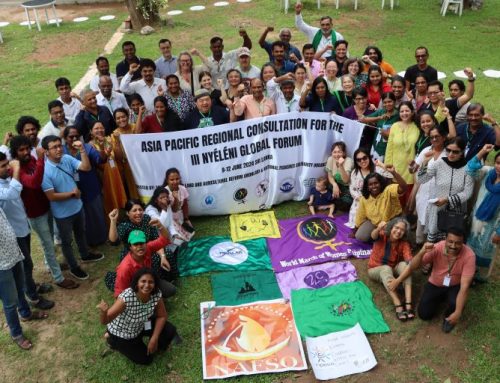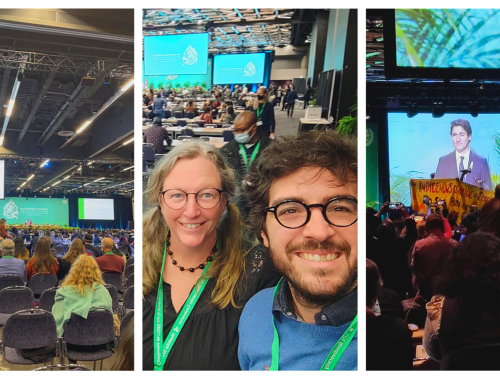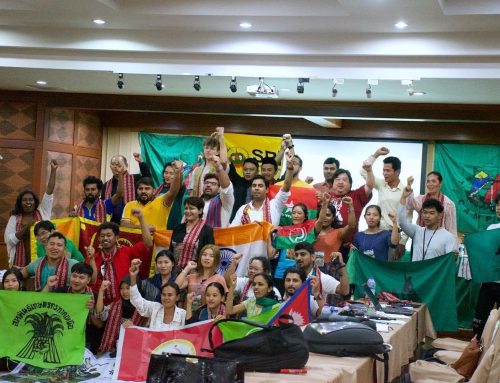July 2010
Four years after the moratorium on Terminator technology was reaffirmed by the United Nations Convention on Biological Diversity (CBD), proposals to develop and commercialize ‘genetic-use restriction technologies’ (GURTs) are back on the agenda for policymakers and the biotechnology industry.
Terminator is a threat to food sovereignty and agrobiodiversity: ending the moratorium on Terminator will increase control of seed by transnational corporations (TNCs) and restrictions on farmers’ rights to save and plant harvested seed. Additionally, pollen from genetically-modified (GM) crops with Terminator will contaminate non-GM and organic crops, and native plant species. GURTs (herein referred to as ‘Terminator’) are genetic engineering technologies that seek to control plant fertility.
First-generation Terminator (also called ‘suicide seed’) was developed by the US Department of Agriculture and Delta and Pine Land Company in the 1990s to protect the intellectual property of US agricultural biotechnology TNCs. GM crops produce sterile seeds to prevent farmers from replanting harvested seed with patented DNA. Due to international public outcry from farmers and civil society worldwide, Terminator has never been commercialized anywhere, and Brazil and India have national moratoriums prohibiting it.
In 2000, the CBD recommended a moratorium on field-testing and commercial sale of Terminator seeds. In 2006, pressure from La Via Campesina and its allies helped to strengthen this moratorium in Curitiba, Brazil. That year, US-based TNC Monsanto Company, the largest seed company in the world, acquired Delta and Pine Land, along with the intellectual property rights to Terminator.
Since then industry, the US and European governments and ultra-rich philanthro-capitalists have ramped up rhetoric on the need for Terminator and other biotechnologies to adapt to the climate, energy and food crises.
Various false solutions are being proposed to sell the lie that techno-fixes allow rich countries to continue consuming resources and emitting carbon dioxide, unabated:
- GM crops for cellulosic and second-generation agrofuels;
- geoengineering ‘climate ready’ GM crops and trees with increased albedo (reflectivity) and resistance to drought, heat and salt;
- monoculture plantation forests of GM trees to industrially produce biochar for carbon sequestration; and
- GM algae and marine microbes for carbon dioxide sequestration.
Monsanto is proposing that monoculture plantations of its Roundup Ready soybeans qualify for carbon credits under so-called “no-till” agriculture. All of these false solutions create new markets for agricultural biotechnology and ‘extreme genetic engineering’. With financing by the US government and British Petroleum (BP), in May, Synthetic Genomics, the company founded.
Craig Venter (which helped to sequence the human genome) announced that it had created the first-ever synthetic, self-reproducing microbe with synthetic biology. Venter’s team claims that the microbe can be used to produce clean, green algal biofuels; however, what will happen if this microbe escapes into the wild and contaminates non-synthetic algae with its DNA? Similarly, what will happen when a GM maize variety engineered to have a high amount of stover (the stalks, husks, etc. of maize) for cellulosic agrofuels contaminates food maize varieties? The implications are frightening.
Industry is now claiming that Terminator is needed to contain genetic contamination (transgene flow) of food crops and other natural life forms from genetically-engineered DNA in non-food crops; in essence, as a precautionary, environmental necessity. Venter recently told the New York Times that Terminator should be employed to contain transgenic contamination. Genetic contamination of non-GM and organic food crops from GM crops, which occurs through the spread of GM pollen by wind and bees, is gaining recognition as a growing ecological and economic problem. On June 21st the US Supreme Court ruled on Monsanto Co vs. Geertson Seed Farms, and recognized that transgenic contamination is “harmful and onerous to organic and conventional farmers,” and grounds for litigation against biotechnology TNCs.
Thus a new generation of Terminator research is focused on biological containment to prevent engineered genetic traits (transgenes) from spreading to non-GM food plants and wild relatives. It is highly unlikely that the industry that created the problem of genetic pollution will solve it with more biotechnology. Given BP’s difficulty to contain the oil spill in the Gulf of Mexico, why would the US government entrust it to contain trangene flow from the world’s first synthetic life form?
Yet that is what is taking place. Europe has funded the Transcontainer Project with billions of euros, and there are proposals from right-wing Brazilian politicians to overturn the country’s national ban on Terminator. While application and commercialization of Terminator technologies can’t promise fail-safe containment of transgenes, they can function to control farmers’ access to seeds and germplasm. Under the guise of environmental security for GM crops, industry will use the new generation of Terminator technologies to tighten its grasp on proprietary germplasm, and restrict the rights of farmers to re-plant harvested seeds.
Further, the likely prospect of contamination of food crops by GM crops engineered with Terminator places the entire global food supply at imminent risk, and it therefore poses unacceptable threats to food and seed sovereignty and agro-biodiversity. TNCs are expanding and consolidating control over the world’s croplands, rangelands, peat bogs and last remaining forests, while simultaneously consolidating control of the genetic commons at cellular and molecular levels.
Terminator technologies for synthetic biology, GM crops for agrofuels, geoengineering and all of the other false solutions to the energy, climate and food crises enclose vast genetic resources and agrobiodiversity, taking them out of the public realm and into the control of TNCs, especially the US Big Biotech giants Monsanto, Dupont and Arborgen. Organizing against Terminator in 2010 – what you can do It is critical that La Via Campesina, small farmers, NGOs and consumers throughout the world organize to stop Terminator’s return.
Pressure by civil society at the CBD meeting in May resulted in two draft moratoriums against synthetic biology and geoengineering, giving a boost to mobilization against Terminator at the next CBD meeting in Nagoya, Japan, October 18-29 2010, where industry will likely try and overturn the moratorium. Because industry’s rhetoric for Terminator is based on false solutions to climate change, organizing against it will also be critical at the UN climate talks in Cancun, Mexico, November 29 to December 10, 2010.
The international coordination of La Via Campesina is asking its members, allies and all consumers to:
- Write letters, request meetings, launch cyber-campaigns, etc. to pressure with your government representatives who will be representing your country in the CBD and UNFCCC negotiations to uphold the moratorium on Terminator in Japan and Cancun. It is vital that organizations and individuals in India and Brazil pressure their governments to maintain national their moratoriums. For your convenience, use and adapt the attached standard letter.
- Send as many people as possible to the CBD and UNFCCC meetings in Japan and Cancun;
Resources
- “The race to make fuel out of algae poses risks as well as benefits.” Dina Fine Maron, Environment and Energy Publishing. July 22, 2010;
- “Exploring Algae as Fuel.” Andrew Pollack, The New York Times. July 26 2010.
- ETC Group Hands off Mother Earth campaign: http://www.handsoffmotherearth.org/
- “Retooling the Planet: Climate Chaos in the Geoengineering Age.” ETC Group, December 2009.
- Terminator: the Sequel. ETC Group, May/June 2007.
- “Peasants victory in defending seeds from Terminator Technology,” La Via Campesina, March 2006.
Contact
Tejo Pramono (Indonesia) tejopramono@viacampesina.org
Isabella Kenfield (US) isabella.kenfield@gmail.com





